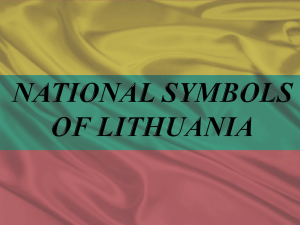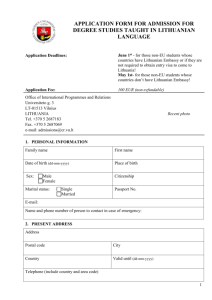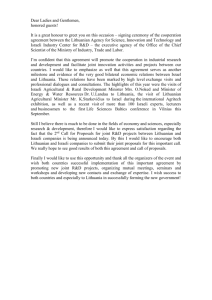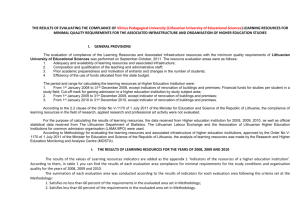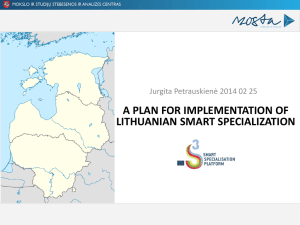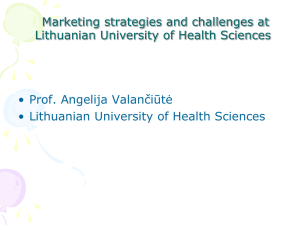Report from the 45th Annual Meeting of Societas Linguistica
advertisement
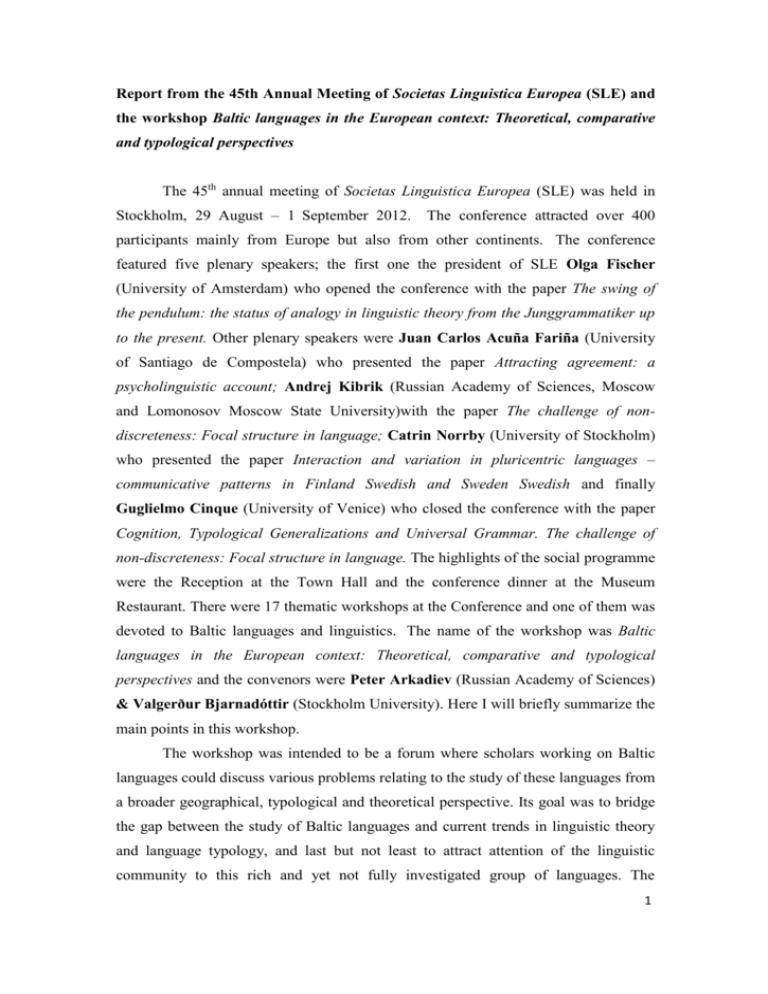
Report from the 45th Annual Meeting of Societas Linguistica Europea (SLE) and
the workshop Baltic languages in the European context: Theoretical, comparative
and typological perspectives
The 45th annual meeting of Societas Linguistica Europea (SLE) was held in
Stockholm, 29 August – 1 September 2012.
The conference attracted over 400
participants mainly from Europe but also from other continents. The conference
featured five plenary speakers; the first one the president of SLE Olga Fischer
(University of Amsterdam) who opened the conference with the paper The swing of
the pendulum: the status of analogy in linguistic theory from the Junggrammatiker up
to the present. Other plenary speakers were Juan Carlos Acuña Fariña (University
of Santiago de Compostela) who presented the paper Attracting agreement: a
psycholinguistic account; Andrej Kibrik (Russian Academy of Sciences, Moscow
and Lomonosov Moscow State University)with the paper The challenge of nondiscreteness: Focal structure in language; Catrin Norrby (University of Stockholm)
who presented the paper Interaction and variation in pluricentric languages –
communicative patterns in Finland Swedish and Sweden Swedish and finally
Guglielmo Cinque (University of Venice) who closed the conference with the paper
Cognition, Typological Generalizations and Universal Grammar. The challenge of
non-discreteness: Focal structure in language. The highlights of the social programme
were the Reception at the Town Hall and the conference dinner at the Museum
Restaurant. There were 17 thematic workshops at the Conference and one of them was
devoted to Baltic languages and linguistics. The name of the workshop was Baltic
languages in the European context: Theoretical, comparative and typological
perspectives and the convenors were Peter Arkadiev (Russian Academy of Sciences)
& Valgerður Bjarnadóttir (Stockholm University). Here I will briefly summarize the
main points in this workshop.
The workshop was intended to be a forum where scholars working on Baltic
languages could discuss various problems relating to the study of these languages from
a broader geographical, typological and theoretical perspective. Its goal was to bridge
the gap between the study of Baltic languages and current trends in linguistic theory
and language typology, and last but not least to attract attention of the linguistic
community to this rich and yet not fully investigated group of languages. The
1
workshop focused on the Baltic language group and specifically on the assessment of
the Baltic material from a broader European areal perspective, including, but not
limited to the Circum-Baltic region, serving as a buffer zone between Eurasia and
Standard-Average European.
The keynote speaker at the workshop was Axel Holvoet (Warsaw University).
The title of this talk was: Baltic as a key area of typological research: The domain of
epistemic, evidential and interpretive marking. He addressed the relation between
epistemic, evidential and interpretive use marking in Baltic and neighbouring
languages. The first two have received ample attention in the linguistic literature. He
argued that interpretive use marking is related to and shows frequent instances of
overlap with epistemic and evidential marking.
The paper of Anna Ruskan, (Vilnius University). Expressing evidentiality in
Lithuanian: the case of neuter adjectives was awarded the second prize by a doctoral
student at the closing ceremony of the conference. She discussed evidentiality and its
expression in Lithuanian. A special focus was the use of the neuter adjectives
akivaizdu, aišku, panašu and natūralu functioning evidentially and she presented a
corpus based research on their use in fiction and academic discourse and explored the
loss of evidential function and acquisition of pragmatic functions.
In her talk On Latvian dative constructions with non-verbal predicates Natalia
Perkova, (Russian Academy of Sciences) discussed the non-verbal predicates
(predicatives) in dative constructions which are very common in Latvian. She tested a
methodology proposed for Russian where predicative are classified according to the
types of derivational and semantic correlations between them and the respective
adjectives. She demonstrated that there is a slow drift from prototypical possessive
constructions to the productive experiential model and that there is a hierarchy of nonverbal Latvian predicates used with dative subjects.
Another talk also dealt with non-canonical subject marking. In her talk Dative
subjects in Lithuanian vs. Icelandic: What do they have in common and where do they
differ? Valgerður Bjarnadóttir, (Stockholm University) compared the dative subject
constructions in Lithuanian and Icelandic. In Icelandic these constructions have been
studied extensively and their status as a syntactic subject is uncontroversial. The
semantics of the verbs taking dative subjects in the two languages were compared and
an analysis of the syntactic behaviour of the dative subject in both Old and Modern
2
Lithuanian was provided and the differences from Icelandic were explained by means
of Circum-Baltic parallels.
Erika Jasionytė (Vilnius University) presented her corpus-based research on
two Lithuanian modal verbs expressing necessity in her talk On the Lithuanian
impersonal verbs reik(ė)ti 'need' and tekti 'be gotten': the rise of modal meanings. She
provided both synchronic and diachronic account of the use, and the semantics of
these two impersonal modal constructions in order to establish to what extent these
two verbs have developed modal meanings. The analysis supports cross-linguistic
observations that impersonal modals are less polyfunctional than personal modals and
they do not develop epistemic values. In contrast to tekti ‘be gotten’, reik(ė)ti ‘need’
has got greater potential to convey deonticity, viz. a subjective deontic meaning and
may thus be somehow further on a grammaticalisation cline than tekti
Hélène de Penanros, (Paris Institute of Orient Languages and Civilizations)
compared two seemingly synonymous constructions with the verb to shoot +
instrumental vs. + the preposition iš and genitive in her paper Šauti šautuvu or iš
šautuvo? About two constructions of the instrument in Lithuanian. Her analysis
revealed that the two constructions are not equivalent but involve different conceptions
of the notion of shooting. The two constructions here are the traces of different
linguistic operations linked to the specific semantics of each marker and the use of a
preposition is not a free option. Her analysis argues for the atomistic thesis, which
considers that each unit is meaningful and contributes to the construction of the
utterance and its meaning.
One paper dealt with Old Lithuanian. That was the paper The pronominal
clitic system of Old Lithuanian in the BalticSlavic areal context by Auksė
Razanovaitė (Vilnius University) who presented her study on the pronominal clitic
system in Lithuanian. She compared the development of the system in Lithuanian with
their development in Slavic languages. The pronominal clitics of Old Lithuanian are
considered to be enclitics i. e. obeying the Wackernagel’s Law and holding the second
position in the sentence, it should be noted however that most of the pronominal clitics
tend to stay adjacent to the verb, even if the verb is not the first word of the sentence.
Old Lithuanian shows relics of pronominal clitics and they are recorded in the oldest
Lithuanian texts but disappear gradually since the 18th century.
3
Björn Wiemer (Johannes-Gutenberg-University Mainz) in his talk (Intensive)
language contact without grammaticalization: a Baltic (and Slavic) anomaly? posed
the problem that Slavic and Baltic share only few cases of grammaticalization that can
be considered as induced by contact with each other despite their long-lasting
intensive contacts and tight genealogical links in prehistory. He addressed the
question whether this lack of contact induced grammaticalization can be regarded as
an anomaly against a European background and whether this lack can be explained by
structural reasons.
In his talk On the typology of recent verbal borrowings in Baltic Jurgis
Pakerys (Vilnius University) demonstrated that both Lithuanian and Latvian follow
the Indirect Insertion (IndI) strategy when accommodating verbal borrowings. The
suffix -uo- in Lithuanian and -o- in Latvian can be considered as typical (denominal)
verbalizing affixes, while Lithuanian -in- and Latvian -ē- are the most productive
causative/factitive markers. Lithuanian and Latvian differ from a number of European
languages by not using the suffix {-Vr-} as a loan verb accommodation affix cf. Swiss
German park-ier-en ‘to park’ < English park, Croatian kidnep-ir-ati ‘to kidnap’ <
English kidnap, etc.
Anna Daugavet, (Saint-Petersburg State university) offered a new analysis of
tones in Lithuanian and Latvian in her talk Register and contour in the analysis of
Latvian and Lithuanian tones. Tones in these languages are usually described in terms
of pitch levels. This paper demonstrated that it is possible to analyse Latvian and
Lithuanian tones in terms of register and contour and that such analysis is also
preferable over an analysis in terms of pitch levels because it captures the relationship
between non-modal phonation and contour tones which is found in dialects of both
languages.
Two other talks outside the workshop also dealt with Baltic languages:
Adriano Cerri (University of Pisa). Number words' frequency in modern Lithuanian;
Andra Kalnača and Ilze Lokmane (University of Latvia). Polyfunctionality and
syntactic distribution of reflexive verbs in Latvian.
To sum up, the papers of this workshop covered a wide range of linguistic
topics and addressed various problems, including morphology, syntax and phonetics
both from a synchronic and diachronic perspective. All in all, the linguistic section
4
made an important contribution to the 45th annual meeting of Societas Linguistica
Europea.
Valgerður Bjarnadóttir
Department of Baltic languages, Finnish and German
Stockholm University
SE-106 91 Stockholm, Sweden
valgerdur.bjarnadottir@balt.su.se
5

